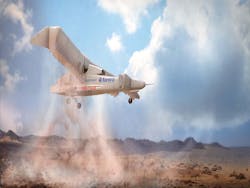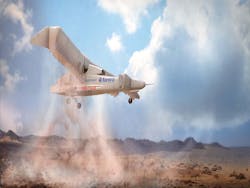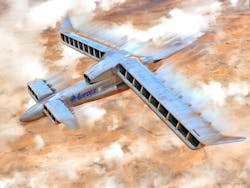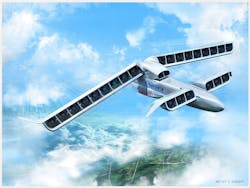Aurora to build DARPA VTOL X-Plane technology demonstrator with hybrid-electric propulsion
MANASSAS, Va., 4 March 2016. Aurora Flight Sciences in Manassas, Virginia, won a prime contract from the Defense Advanced Research Projects Agency (DARPA) in Arlington, Va., to build the agency's Vertical Takeoff and Landing (VTOL) Experimental Plane (X-Plane) under Phase 2 of the program.
"Aurora is proud to support DARPA on what we all hope to be a truly historic breakthrough in aviation technology," says Dr. John Langford, chairman and CEO of Aurora. "If successful, VTOL X-Plane's radically improved flight capabilities could lead to revolutionary advancement of the U.S. military's future mission capabilities. We're honored to have been selected by DARPA to build and flight test the demonstrator aircraft."
The VTOL X-Plane technology demonstrator is intended to:
- Achieve a top sustained flight speed of 300 kt-400 kt
- Raise aircraft hover efficiency from 60 percent to at least 75 percent
- Present a more favorable cruise lift-to-drag ratio of at least 10, up from 5-6
- Carry a useful load of at least 40 percent of the vehicle's projected gross weight of 10,000-12,000 pounds
The Aurora team's design for its unmanned aircraft, named LightningStrike, seeks to provide an approximately 50-percent increase in speed over existing VTOL aircraft designed for comparable mission applications.
The technology demonstrator was designed in close collaboration with Aurora's team members, Rolls-Royce PLC and Honeywell International Inc. The Aurora-led team intends to deliver a number of aviation milestones with the demonstration aircraft, including being the first aircraft designed to demonstrate:
- Distributed hybrid-electric propulsion ducted fans
- An innovative synchronous electric-drive system
- Both tilt-wing- and tilt-canard-based propulsion for vertical takeoff and landing
- High efficiency in both hover and high-speed forward flight
The aircraft design features a Rolls-Royce AE 1107C turboshaft engine that would power three Honeywell generators, and 24 ducted fans distributed on both the wings and canards.
The aircraft's electric distributed propulsion (EDP) system would consist of integrated, distributed ducted fans that, combined with the synchronous electric drive system, would enable the design's potentially revolutionary hover efficiency and high-speed forward flight.
"The Aurora team's goal is to help redefine the future of vertical flight," says Mark Wilson, chief operating officer of Rolls-Royce LibertyWorks, an advanced aerospace technology research and design unit. "Rolls-Royce LibertyWorks is proud to contribute both proven components and innovative new technologies in turbo-electric distributed propulsion to this exciting program."
"Honeywell is proud to be a part of the Aurora team and contribute to this groundbreaking aviation research," adds Carey Smith, president of Honeywell Defense and Space. "Our goal is to demonstrate technology that significantly improves electric power-generation efficiency, power density and size. The improvements are needed to meet the aggressive goals for this very innovative aircraft, and would raise the bar for electric power-generation efficiency that would enable this revolutionary advance in hybrid-electric aircraft propulsion."
The DARPA technology demonstrator's flight control system (FCS) builds on the heritage of Aurora's Centaur and Orion optionally manned and unmanned aircraft platforms. The FCS system runs on a triplex-redundant design to ensure detection and correction of flight anomalies in both vertical and forward flight.
Pending completion of key program milestones to be achieved in close collaboration with DARPA, Aurora plans to conduct the first flight tests of the technology demonstrator in the 2018 timeframe.
Aurora Flight Sciences develops and manufactures advanced aerospace vehicles. Aurora is headquartered in Manassas, Va., and operates production plants in Bridgeport, West Virginia and Columbus, Miss.; and a Research and Development Center in Cambridge, Mass.
You might also like:
Subscribe today to receive all the latest aerospace technology and engineering news, delivered directly to your e-mail inbox twice a week (Tuesdays and Thursdays). Sign upfor your free subscription to the Intelligent Inbox e-newsletter at http://www.intelligent-aerospace.com/subscribe.html.
Connect with Intelligent Aerospace on social media: Twitter (@IntelligentAero), LinkedIn,Google+, and Instagram.
Intelligent Aerospace
Global Aerospace Technology NetworkIntelligent Aerospace, the global aerospace technology network, reports on the latest tools, technologies, and trends of vital importance to aerospace professionals involved in air traffic control, airport operations, satellites and space, and commercial and military avionics on fixed-wing, rotor-wing, and unmanned aircraft throughout the world.




